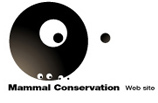The 'Mammal Conservation Web Site' is a portal site: a transfer point for knowledge about the protection of European mammals and a directive/directing-post to a variety of information sources on the internet. The site is originally Dutch but is also completely translated into English. Nevertheless it is multilingual and you will find links to sources in several languages - mostly Dutch, English, French and German. The purpose of the site is to inform about methods and techniques for the conservation of mammals and to show the results of direct action(s). This means that information is given which only deals with protection measures and management techniques for mammals resulting from conservation plans or actions. For information about the biology and ecology of species you will have to look on other web sites, although there are a few exceptions.
It is not the intention of the producers of this site to publish their own material. The function of the site is to act as an information hub. This means that the content of this web site depends on the quality and quantity of the information that is available elsewhere - especially on web sites - on the internet or which is delivered by site-visitors. To exchange this knowledge it is important to know where and what kind of digital information sources are available. The information pages available on the internet can be in several formats including web sites, digital magazines(E-magazines), documents (mostly pdf- or Word-format files) or presentations (for example in PowerPoint). If you are aware of additional web sites or digital documents not posted on the site, please feel free to supply any links so they can be placed on this web site after evaluation by the webmaster.
|
|

